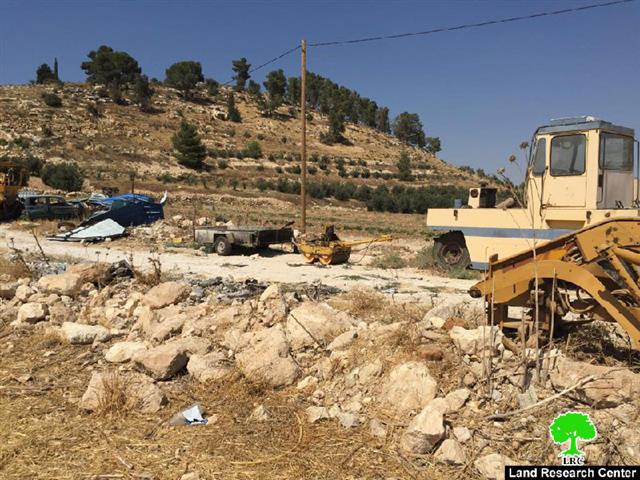Violation: demolishing commercial structures
Location: Idhna village- Hebron
Date: 21/07/2015
Perpetrators: Israel Civil Administration and army
Victims: residents of Idhna
Details:
The Israeli occupation authorities on July 21, 2015 demolished commercial structures owned by people from the village of Idhna, west Hebron. A massive force from the Israel Civil Administration and army troops raided the village of Idhna at 5:00 a.m. in the morning. Two dozers accompanying the force embarked on demolishing a structure in there; the force then moved to the eastern side of the village and carried out another demolition. Land Research Center documented the demolitions as follows:
- Demolition in the area of Khallet Ibrahim:
The Israeli occupation authorities leveled a junk yard that is owned by citizen Sa’id Bshir. The metal slabs barrack was established in 2010 with an area of 300m2.
Photos 1-4: signs of the barrack’s demolition
Citizen Bshir said that the force surrounded the structure, cut the power off, and embarked on demolishing it without allowing the owner to bring any of the interior out.
It should be marked that citizen Bshir was served a stop-work order on his structure under the claim of “unlicensed construction” but he did not neither object it nor apply for a license, believing that Israelis will never grant him one.
Bshir losses totaled 40,000 INS; his family of six members in addition to his brother and parents are now off livelihood due to the destruction of the barrack, which is their only source of living.
- Demolition in the area of Al Galatia:
The Israeli occupation authorities demolished two structures in the eastern side of the village, which are owned by citizens Marwan Tumaizi and Fatthi Sha’rawi. Dozers leveled down Fatthi’s junk barrack that was established in 2009 on a five dunum plot. Also, dozers reached out a retaining wall of 150m, another one of 100m, a 30m2 room and a shed of 50m2.
Photos 4-9: signs of destruction on Sha’rawi’s
Sha’rawi said that the Israeli occupation authorities demolished the structures with the interior still inside. Sha’rawi also said that he was served a stop-work order on December 21, 2014 and that he hired an attorney to object to the order.
Photo 10: the stop-work order on Sha’rawi’s
Sha’rawi’s losses totaled 150,000 INS; his family of 5 members and his brother’s five member family in addition to six workers are now off livelihood due to the destruction of the structure.
The dozers of the occupation also reached out a barrack and a metal slabs wall owned by Citizen Marwan Tumaizi in the eastern part of the village. The 150m2 barrack is founded on a 2 dunum plot, which is surrounded by a 450m metal slabs barrack.
Photos 11-12: signs of destruction on Tumaizi’s
The Israeli occupation authorities also confiscated two equipments containers through winch trucks; Tumaizi was served a minute of confiscation as a result. Noteworthy, Tumaizi was served a stop-work order on December 31, 2014 and on February 2015.
About Idhna:
It is 18km to the west of Hebron. According to statistics conducted in 2007, Idhna is inhabited by 19,012 people. It has a total area of 26,152 dunums, of which 2653 dunums are the village’s built-up area.
The Israeli occupation confiscated 107 dunums of Idhna for the favor of the Apartheid Wall. Furthermore, 3,511 dunums were isolated behind the wall as a result of its construction. Besides, bypass road number 35 -that is 4,674 meters long- confiscated more than 467 dunums from the village’s lands.
House demolitions contradict with all the International conventions and Humanitarian laws including:
Article 17 of the (1948) Universal Declaration of Human Rights stating: “Everyone has the right to own property alone as well as in association with others. No one shall be arbitrarily deprived of his property.”
Section ‹G› of article 23 of the (1907) The Hague Conventions asserting: “In addition to the prohibitions provided by special Conventions, it is especially forbidden to destroy or seize the enemy's property, unless such destruction or seizure be imperatively demanded by the necessities of war.”
Article 53 of the Geneva Fourth Convention (1948) declaring: “Any destruction by the Occupying Power of real or personal property belonging individually or collectively to private persons, or to the State, or to other public authorities, or to social or cooperative organizations, is prohibited, except where such destruction is rendered absolutely necessary by military operations.”
Section 1, Article 11 of the International Covenant on Economic, Social and Cultural Rights (1966): “The States Parties to the present Covenant recognize the right of everyone to an adequate standard of living for himself and his family, including adequate food, clothing and housing, and to the continuous improvement of living conditions. The States Parties will take appropriate steps to ensure the realization of this right, recognizing to this effect the essential importance of international co-operation based on free consent."
Prepared by
The Land Research Center
LRC

























